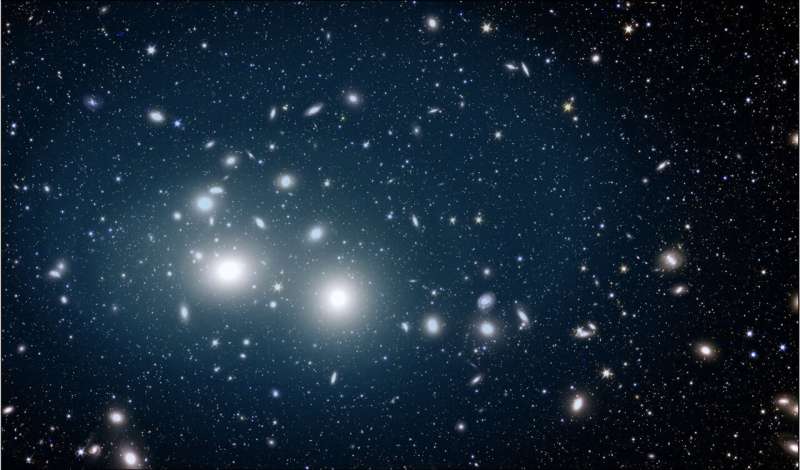This article has been reviewed according to Science X's editorial process and policies. Editors have highlighted the following attributes while ensuring the content's credibility:
fact-checked
trusted source
proofread
Scientists reveal first data from Euclid telescope, offering snapshot of cosmic history

Scientists have released the first set of scientific data captured with the Euclid telescope, showing an exciting glimpse of the universe's distant past.
The telescope, launched in July 2023, is part of the Dark Energy Satellite Mission, which aims to map the dark universe.
Led by the European Space Agency in collaboration with The Euclid Consortium—which includes astronomers at The University of Manchester in leadership positions—the mission seeks to unlock mysteries of dark matter and dark energy, and reveal how and why the universe looks as it does today.
Early observations, described in a series of scientific papers published today, include five never-before-seen images of the universe.
The papers also describe several new discoveries including, free-floating new-born planets, newly identified extragalactic star clusters, new low-mass dwarf galaxies in a nearby galaxy cluster, the distribution of dark matter and intracluster light in galaxy clusters, and very distant bright galaxies from the first billion years of the universe.
The findings give an insight into the unprecedented power of the Euclid telescope, which is designed to provide the most precise map of our universe over time and demonstrates Euclid's ability to unravel the secrets of the cosmos.
Christopher Conselice, Professor of Extragalactic Astronomy at The University of Manchester, said, "Euclid will completely revolutionize our view of the universe. Already these results are revealing important new findings about local galaxies, new unknown dwarf galaxies, extrasolar planets and some of the first galaxies. These results are only the tip of the iceberg in terms of what will come. Soon Euclid will discover yet unknown details of the dark energy and give a full picture of how galaxy formation occurred across all cosmic time."
Michael Brown, Professor of Astrophysics at The University of Manchester, added, "The exceptional data that Euclid is delivering over a large fraction of the sky promises to revolutionize our understanding of dark energy. It is extremely exciting to be part of the team working to extract these headline science results."
The Early Release Observations program was conducted during Euclid's first months in space as a first look at the depth and diversity of science Euclid will provide. A total of 24 hours were allocated to target 17 specific astronomical objects, from nearby clouds of gas and dust to distant clusters of galaxies, producing stunning images that are invaluable for scientific research. In just a single day, Euclid produced a catalogue of more than 11 million objects in visible light and five million more in infrared light.
The images published today follow the return of the space telescope's first full-color images of the cosmos produced in November 2023.
In addition to contributions to the mission's primary objectives, scientists at The University of Manchester, in collaboration with the University of Massachusetts Amherst, conducted a preliminary search of the data for distant galaxies. The red galaxies in the image show the cluster, which acts as a magnifying glass to reveal more distant sources behind. In total, 29 galaxies were discovered providing insight into the first billion years of the universe.
Dr. Rebecca Bowler, Ernest Rutherford Fellow at The University of Manchester, said, "In these spectacular images we can see galaxies that were previously invisible, because the most distant galaxies can only be discovered using the longer near-infrared wavelengths seen by Euclid. This first-look data has been invaluable to test our search algorithms and identifying challenges, such as confusion of distant galaxies with brown dwarfs in our own Milky Way, before we start working on the main data later this year.
"What is amazing is that these images cover an area of less than 1% of the full deep observations, showing that we expect to detect thousands of early galaxies in the next few years with Euclid, which will be revolutionary in understanding how and when galaxies formed after the Big Bang."
The images obtained by Euclid are at least four times sharper than those that can be taken from ground-based telescopes. They cover large patches of sky at unrivaled depth, looking far into the distant universe using both visible and infrared light.
The next data release from the Euclid Consortium will focus on Euclid's primary science objectives. A first worldwide quick release is currently planned for March 2025, while a wider data release is scheduled for June 2026. At least three other quick releases and two other data releases are expected before 2031, which corresponds to a few months after the end of Euclid's initial survey.
The Euclid Consortium includes more than 2,600 members, including over 1,000 researchers from more than 300 laboratories in 15 European countries, plus Canada, Japan and United States, covering various fields in astrophysics, cosmology, theoretical physics, and particle physics.
Josef Aschbacher, ESA Director General, said, "Euclid demonstrates European excellence in frontier science and state-of-the-art technology, and showcases the importance of international collaboration.
"The mission is the result of many years of hard work from scientists, engineers and industry throughout Europe and from members of the Euclid scientific consortium around the world, all brought together by ESA. They can be proud of this achievement—the results are no small feat for such an ambitious mission and such complex fundamental science. Euclid is at the very beginning of its exciting journey to map the structure of the universe."
More information: Euclid's Early Release Observations science papers will be available from 23 May 2024 onwards: www.euclid-ec.org/science/publications/
Provided by University of Manchester





















